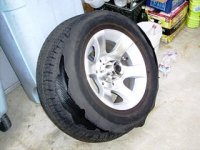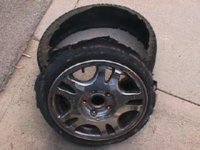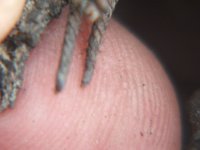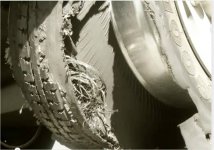tireman9
Well-known member
So Roger can you explain how Carlisle has raise the max speed of their ST tires like the Radial Trail RH? Chris
Its easy. Just run a drum test for a few minutes and you can claim the tire "passes" the requirement for the speed symbol.
My point is that the fundamental basis for the load formula was developed back in the 60's & 70's when the National Speed Limit was 55 mph. There has not been any substantive change to the formula since then. Even though highway speeds are now much faster than 55. It is also important to remember than in 2002 other tires like LT and P type had a major overhaul of the regulatory requirements to make radials more robust but it is my understanding that the RV industry opposed the application of stricter, modern requirements be applied to ST type tires.
DOT regulatory test requirements for ST tires are over 40 years old and the only requirements for "High Speed" are as follows from FMVSS 571.109
"S5.5 High speed performance.S5.5.1 After preparing the tire in accordance with S5.4.1, mount the tire and wheel assembly in accordance with S5.4.2.1, and press it against the test wheel with a load of 88 percent of the tire's maximum load rating as marked on the tire sidewall.
S5.5.2 Break in the tire by running it for 2 hours at 80 km/h (50 mph).
S5.5.3 Allow to cool to 38° ±3 °C (100° ±5 °F) and readjust the inflation pressure to the applicable pressure specified in Table II.
S5.5.4 Without readjusting inflation pressure, test at 121 km/h (75 mph) for 30 minutes, 129 km/h (80 mph) for 30 minutes, and 137 km/h (85 mph) for 30 minutes."
NOTE the above applies to a new tire only and the inflation in "Table II" is 2 psi below the max on the tire sidewall. Once a tire completes the above without visible failure it is considered to have "passed" the test. You will note the relative short cumulative time and that the test is on a new tire that has never hit a pot hole or curb, or been exposed to sunlight for weeks or months.
SOURCE Here
LT tires must meet the following under 571.139
"S6.2.1.2 Test procedure.
S6.2.1.2.1 Press the assembly against the outer face of a test drum with a diameter of 1.70 m ±1%.
S6.2.1.2.2 Apply to the test axle a load equal to 85% of the tire's maximum load carrying capacity.
S6.2.1.2.3 Break-in the tire by running it for 2 hours at 80 km/h.
S6.2.1.2.4 Allow tire to cool to 38 °C and readjust inflation pressure to applicable pressure in 6.2.1.1.1 immediately before the test.
S6.2.1.2.5 Throughout the test, the inflation pressure is not corrected and the test load is maintained at the value applied in S6.2.1.2.2.
S6.2.1.2.6 During the test, the ambient temperature, measured at a distance of not less than 150 mm and not more than 1 m from the tire, is maintained at not less than 32 °C or more than 38 °C.
S6.2.1.2.7 The test is conducted, continuously and uninterrupted, for ninety minutes through three thirty-minute consecutive test stages at the following speeds: 140 (86mph) , 150 (93 mph), and 160 (99 mph) km/h.
S6.2.1.2.8 Allow the tire to cool for between 15 minutes and 25 minutes. Measure its inflation pressure. Then, deflate the tire, remove it from the test rim, and inspect it for the conditions specified in S6.2.2(a).
S6.2.2 Performance requirements. When the tire is tested in accordance with S6.2.1:
(a) There shall be no visual evidence of tread, sidewall, ply, cord, innerliner, belt or bead separation, chunking, open splices, cracking, or broken cords.
(b) The tire pressure, when measured at any time between 15 minutes and 25 minutes after the end of the test, shall not be less than 95% of the initial pressure specified in S6.2.1.1.1."
Source here.
Note the test pressure in 6.2.1.1.1 is about 5 psi below the max on the tire sidewall.
Also remember that an LT225/75R15 LR-D carries 15% less load than an identically sized ST type tire. I would ask what part of physics allows an ST to carry more load at the same inflation as an LT if all other conditions of use are identical?? Just making the container stronger doesn't result in increased load capacity.
If you want to learn more about the speed rating test tire companies are using I suggest you read This post written by another tire engineer.





